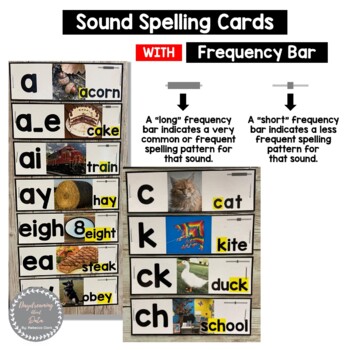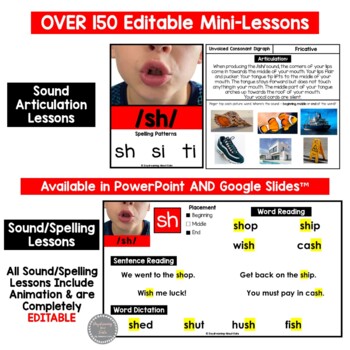Sound Wall Phonics Lessons Science of Reading
- Zip
Description
Sound wall with REAL pictures, PLUS editable sound wall mini-lessons!
A sound wall is an interactive instructional tool that supports students as they develop into proficient readers and writers. Unlike a traditional word wall, a sound wall focuses on the individual speech sounds (phonemes) in English and the spelling patterns (graphemes) that represent those sounds. Sound walls help students develop strong phoneme grapheme connections.
This sound wall includes everything you need to support students as they transition from speech (spoken language) to print (reading and writing). To help you get started integrating this sound wall into your daily routine, I have included over 150 digital (EDITABLE) Sound Wall Mini-Lessons. All spelling patterns come with an explicit and systematic mini-lesson that includes, proper sound articulation, sound identification, sound placement, word reading, sentence reading and word dictation (spelling). I have also included a description of all key spelling generalizations in the slide margins. For example, I describe all the key patterns that are important to teach when introducing or reviewing each sound such as, when to use a _CK instead of a C or K, when _dge is used, and why words such as horse, goose and large have a final silent E.
Mini-lessons come in both PowerPoint AND Google Slides™!
This sound wall can be used with any curriculum or program to strengthen instruction and promote proficient foundational skills in reading and writing!
The sound wall itself, has two main components – a vowel wall (commonly referred to as a vowel valley) and a consonant wall (I call it a consonant corner). Both components, force students to pay close attention to the individual sounds and the graphemes or spelling patterns that represent those sounds.
All graphemes (spelling patterns) are listed in order of frequency. Please see Hanna’s research in the Journal of Literacy Research to learn more.
***Be sure to check out the preview file for more of what's included***
This Resource Includes:
- 27 Consonant Mouth Articulation Photo Cards – each card includes spelling patterns (graphemes) in order of frequency
- 19 Vowel Mouth Articulation Photo Cards – each card includes spelling patterns (graphemes) in order of frequency
- Spelling Pattern Cards with REAL pictures. Spelling cards include two printing options; The first set includes a frequency bar that depicts the frequency of each spelling pattern (see preview file for more information). The second is without the frequency bar. Each card includes a mentor picture, anchor word, and grapheme
- Sound Articulation Labels: Includes title cards and category cards for each part of the vowel valley and consonant wall
- Vocabulary definition cards (vowel, consonant, voiced, unvoiced, ect.)
- Locked placeholder cards meant to act as placeholder cards- you can choose to attach each placeholder to each spelling pattern card to “lock” that particular pattern until you teach it or to “hold” the spot on your wall or bulletin board if you choose to add each spelling card as you teach it.
- OVER 150 Sound Wall Digital Mini-Lessons that can be added to ANY curriculum or program- Available in PowerPoint AND Google Slides; Including a description of all key spelling generalizations and patterns for each sound.
- Alphabet Line (with real pictures) to correspond with the sound wall. Vowels include a short vowel anchor picture option and short and long vowel anchor picture printing option.
- Student Printables and Extras: Individual Sound Wall (color & blackline printing options), Alphabet Chart, Sound Wall Student Dictionary, Long Vowel Chart and MORE!
Please note that this is a very LARGE file. You will download a compressed .zip folder that contains seven PDF documents, a large PowerPoint presentation (mini-lessons) as well as get a link to make a copy of the mini-lessons in Google Slides. You will need software to open a PDF file such as Adobe Acrobat. You may print as many copies of the individual student sound wall as needed for the students that you personally teach! Additional licenses for ALL other documents MUST be purchased for use by other teachers.
You May Also Like Backward Decoding:
Or Individual Short Vowel Sets:
Or Maybe...
Be the first to know about my new discounts, freebies and product launches:
CLICK HERE to receive updates on new products, sales, and freebies! I discount ALL new products up to 50% off for the first 24 hours. It really does pay to follow me!
*****************************************************************************
Customer Tip:
Don’t forget that leaving feedback earns you points towards FREE TPT purchases.
I truly do value your feedback!
⭐️ What are TpT Credits?
You can gain TpT credits by going back and leaving feedback on any purchases that you have made. The credits build up and then you can use them towards future purchases! The credits REALLY do add up!
I love to see my resources in action! Find me @daydreamingaboutdata on TiKTOK, Instagram and Facebook!
If you have any questions, please feel free to email me at daydreamingaboutdata@gmail.com
I appreciate YOU!!
Sincerely,
Rebecca @ Daydreaming-About-Data





